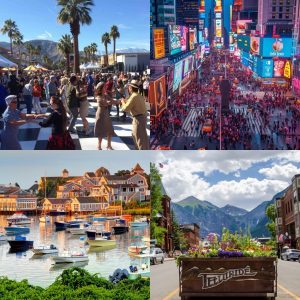Widgetized Section
Go to Admin » Appearance » Widgets » and move Gabfire Widget: Social into that MastheadOverlay zone
Governance: Part II: Culture
The views expressed are those of the author and do not necessarily reflect the views of ASPA as an organization.
By Troy Chavez
January 27, 2025

Culture and governance are married forever. No annulments. This may seem harsh or hyperbolic, but it isn’t. The only separation here is the type of culture and type of government. Someone residing in New York will have a different type of government than someone living in Topeka, Kansas. Their governments still operate similarly under our democratic, constitutional system, but local governance enlarges or shrinks based on its culture (population)—and commerce (business activity/creation).
The best—and overused—example is Detroit, Michigan. Once a bustling metropolis and King of the Road, it crumbled into ruin and stagnation. The culture would then shift alongside the great migration of Black Americans from the south looking for work. This would shape the local culture for generations to come.
Migration is the usual vector for cultural changes—and employment. This occurs domestically and externally. Cities can’t move, neither states nor countries. Governments are not venture capitalists and must work with the land, people and commerce they have. They can attract, yes, but they can’t pack up the city and move to a new, tax-friendly office in say, Texas, like a business would.
I hammer this home because local culture is crafted with a sharp chisel, taking generations for a face to emerge. Meaning, they can be literally cemented in their ways (via architecture & local monuments). This cultural component trickles up and down. Localism, in the United States, is treasured. Our local identities express to the big-wide world that we exist, are cultured and don’t want anyone mucking up what we have. This type of governance juxtaposes that of China’s whereby central authority rules government, instead of hyper-local jurisdictions.
Moreover, let’s compare China to the U.S. for a moment. China’s total population is larger than the U.S. (4.11 times larger) with a homogeneous (90 percent of China’s population identifies as “Han Chinese”) opposed to a heterogeneous society (ethnicity is shared between White, Black/African American, Hispanic/Latino and Native American and other mixed races/ethnicities) in U.S.). Additionally, immigration is viewed (and used) differently in both countries. Immigration shapes U.S. culture more vastly than China’s. Nearly 15 percent of the U.S. population is foreign born. Comparatively, China’s is only 0.1 percent of the population. Western countries like Germany (15.7 percent) or France (12.8 percent) and others, generally, have higher foreign-born residents than China—even less than their Asiatic neighbors like Japan (2.0 percent) and South Korea (2.3 percent). This cultural dynamic vehemently influences policy, laws, and general decision making. We can view the differences between China and the U.S. as a hive mind (China: state, singular) vs. a conglomeration of local powers (U.S: states, plural).
When people think of Democracy, they often think of messy moving parts and actors. This is true, but that is how the sausage is made. Winston Churchill once said, “Indeed, it has been said that democracy is the worst form of Government except all those other forms that have been tried from time to time; but there is the broad feeling in our country that the people should rule, continuously rule and that public opinion, expressed by all constitutional means, should shape, guide and control the actions of Ministers who are their servants and not their masters.”
Can we improve our system? Yes. But we should start looking in the right place for those solutions. Burning down the forest to plant new trees is just silly. Our system has many flaws, but these are largely people flaws exfoliated because of corruption and greed. That is why the first part of this series spoke on laws. Their careful application proliferates and propels society forward. Laws are like roads. They need to be smooth, wide enough (yet confined), and perpetually maintained. Laws and culture are feedback loops. Albeit once they stop speaking and corroborating, we get laws like those leading to the failed “War on Drugs.”
Laws are branches of one’s cultural tree. And its leaves are architecture. The buildings scattered about reflect and illustrate local accomplishments and accents. Let’s look at this in three ways: personal, domestic and compare with foreign entities (China, etc.).
In North Carolina, the first thing I saw were churches on seemingly every street corner. Equivalent to seeing Starbucks when I lived in Southern California. I reside in a portion of the south called the “bible belt.” I did not know this could be a literal beltway crossing myriad states. These churches affect local culture in obvious and subtle ways. Churches illustrate to visitors the deeply imbedded faith interwoven throughout the south. Subtly, they are doubly cemeteries, food pantries and temporary housing.
“I have to save this church from going under,” said a woman I worked with on the campaign trail in 2022. “Both my parents are buried there and if the church goes under, I don’t know what they’ll do with the plots….” The church is more than a place of worship. It is a North Star and lifeline for local communities in my region. In Greensboro, NC, an organization called Greensboro Urban Ministry (GUM) does just that.
This small, personal example shows how one aspect can drastically alter an environment. Years of religious proclamation has produced the “Bible Belt.” It was not done overnight. I did not even paint a comprehensive portrait of southern culture. I picked up one pebble from its deep, roaring river. Architecture is a projection to the world. And what is projected stems from that society’s cultural nucleus.
Author: Troy Chavez, M.P.A. is a PhD candidate at Liberty University with a masters in public administration and works in government doing community relations. He can be reached at [email protected].


Follow Us!